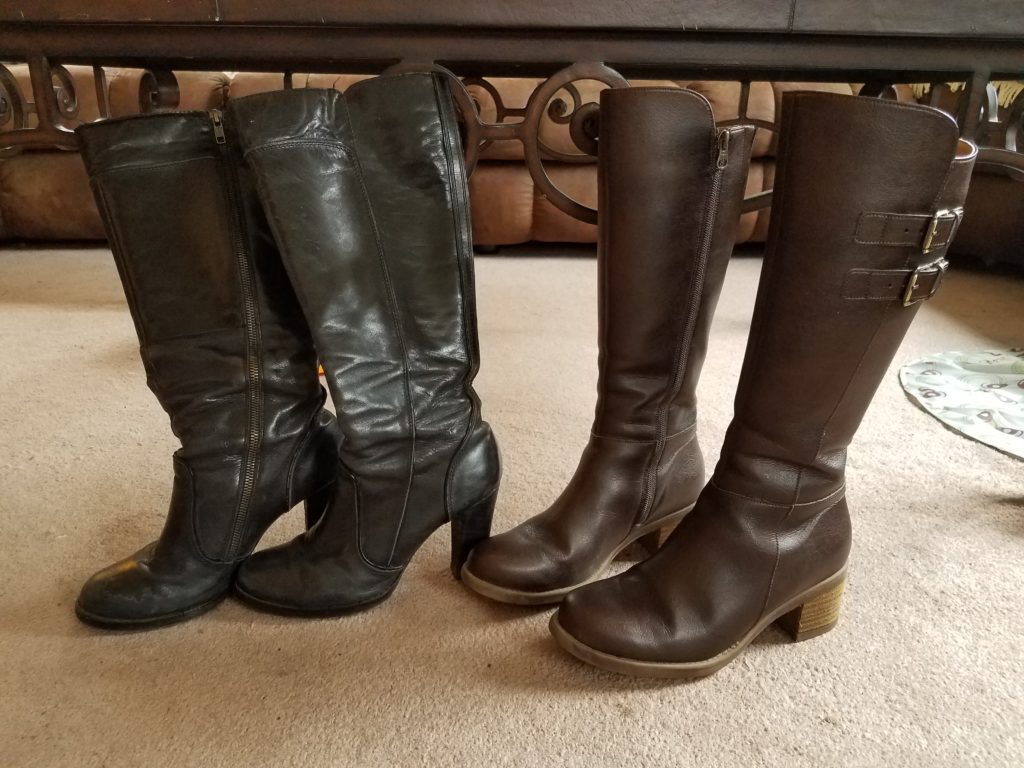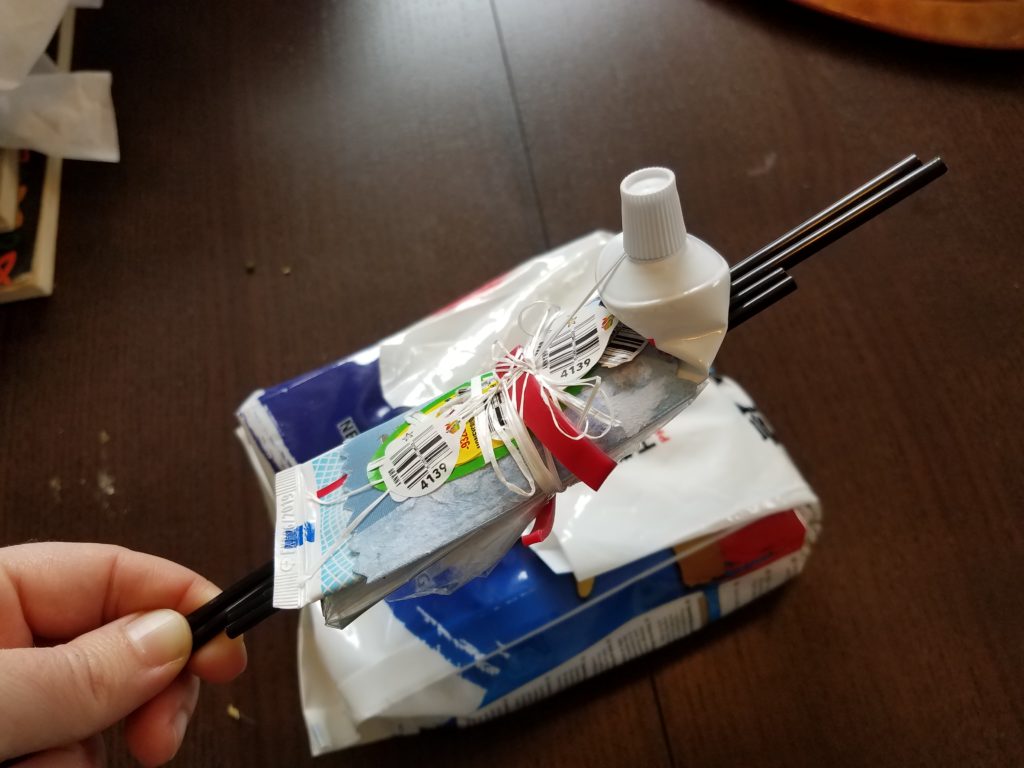I often joke that my second X-chromosome is lazy because I absolutely hate shopping for clothes. I consider it an absolute pain to go to the mall, look through the racks, try things on, etc. I find it to be a time-sink, and I don’t get any pleasure out of it. I have had body image issues pretty much constantly since adolescence, which probably plays a big part in why I don’t get much enjoyment from shopping for clothes. Consequently, I keep my clothes until they are literally falling apart, and even then, I keep them in piles with the intention of mending them. Occasionally, I will bite the bullet and cut them up to use as rags, but that’s only if they are completely unsalvageable.
I try to take pretty good care of my clothes, so I still have some functional items from when I was in high school. That, by the way, is great for wardrobe variety: “Oh, is that new?” / “No, it’s old. Very old.” But, sadly, my favorite, most comfortable things that get the most wear eventually reach the end of their useful life.
I hadn’t expected to need to shop for clothes during Lent because 1) shopping is something I don’t like to do, so I typically don’t think about it anyway, and 2) Lent is a six-week commitment; what could I possibly need to buy in those six weeks? Of course, this challenge is about opening my eyes to things I hadn’t considered, so as certain clothing items are giving up the ghost, I’m becoming aware of what I should and shouldn’t do to replace them (both during Lent and in the future).
Stockings: A Necessary Evil?
As I mentioned, I have body image issues. I have had pretty bad varicose veins since middle school, which have always made me too self-conscious to walk around with bare legs. I never wear shorts unless it is over 100 degrees in the summer. I have several pairs of knee-high boots to cover my calves if I’m wearing a skirt. If I’m in a dress or suit, I would never dream of going without panty hose – not just because of my legs, but because I can’t imagine not wearing them in a professional/formal situation. (Two years of working in Japan was enough to permanently shift my idea of “appropriate” work attire: no sleeveless tops, no open-toed shoes, and NEVER no panty hose.)

https://www.smithsonianmag.com/arts-culture/stocking-series-part-1-wartime-rationing-and-nylon-riots-25391066/
Stockings used to be made out of silk, but even early nylon models made by DuPont in the 1940s were more durable than what we’ve got today. Nylon is a strong fabric – it’s used to make parachutes – but sometimes an unlucky pair of stockings doesn’t last a whole day. As careful as you are, you will always, eventually catch them on something or your toenail will wear a hole in them from rubbing against your (close-toed) shoe. I have used plenty of clear nail polish to catch runs when they start, and I have had several pairs over the years that I can only wear with tall boots because of a run below the knee, or with a long skirt because of a run above the knee. I have adjusted my outfit for the day on many a morning because of what panty hose were clean and available at the time.
As I mentioned in my “Ground Rules” post a few weeks ago, I did not stockpile anything I thought I would need to buy during Lent (with the exception of a day planner). That means that when my last pair of stockings finally wore out on Ash Wednesday, I was really out of luck.
Since then, I have attended five events for work (ranging from professional to formal) and four public speaking engagements where I was representing my company. I have also dressed up in costume for two personal events: going to see the Rocky Horror Picture Show and hosting the Neon Genesis Evangelion party at our house, involving short shorts and a short dress, respectively. I also wore a skirt (in lieu of a dirndl) when I was invited to be the ceremonial keg tapper at Hofbrauhaus this week. I have had some anxiety about the impropriety of not wearing stockings for the work events and the appearance of my legs in general, but after some research, I think I’m going to avoid them whenever possible after Easter, self-consciousness be damned.
Nylon is a plastic that is incredibly energy-intensive to make, and the process produces nitrous oxide, which is almost 300 times worse than CO2 as a greenhouse gas.[1] There are companies that are working to make stockings from recycled plastics instead of virgin plastics,[2] but because of how the nylon and spandex are twined together, it’s not currently possible to separate the component materials and turn them into new stockings.
Apparently you can still purchase silk stockings, and they are indeed a luxury good. This pair I found from a store in Paris will run you $42.80.[3] But of course, they’re not stretchy, so you’d need to size them properly. Also, you would need to be comfortable buying silk, which many animal welfare advocates are not. Silk worms are killed while in their cocoons in order to preserve the silk they have spun to encapsulate themselves. For that reason, I have not purchased silk since learning that fact, even though there are environmental benefits of choosing a natural fabric over a synthetic fabric. I run into the same issue with leather, and that brings me to…

Shoes
I am in a similar situation with my shoes. I have a pair that I have loved dearly for about ten years (shoes – not the boots pictured above). They are attractive, comfortable, and they have picked up road dust on three continents. I’ve had them repaired at least three times, but I now cannot wear them if it’s rainy because the leather is separating from the sole. It breaks my heart to get rid of them, but they have served me well for a long time.
The argument for natural materials (like leather) is that they are durable but ultimately break down more easily than synthetics. The argument for synthetics is that you don’t have to (at best) use or (at worst) kill an animal to get them. I have not yet done a Life Cycle Analysis of the vegan leather (plastic) boots I bought earlier this year, but I would like to. I can already confirm that they are not as comfortable or durable as the leather boots I wear all the time and have had for at least ten years (and also have had repaired once or twice).
This discussion warrants more attention than a quick paragraph, especially since it deals with issues of morality as well as carbon footprint. If nothing else, this Lent is giving me great ideas for topics to cover in greater depth later. So for now, I’ll finish up with a quick summary on…
Dresses
Let’s return quickly to the fact that I loathe shopping. A year or so ago, I decided to check out an online clothing company that showed up in my Facebook feed. This company offered stylish, custom-sewn dresses at reasonable prices. These dresses were designed in New York, stitched in Delhi, and shipped to your door. I was curious about the prospect but skeptical about the manufacturing conditions in India. Everything I was able to find on this company indicated that they do actually pay their stitchers more than minimum wage, and that shop conditions are good with fresh air and natural daylight. [4]
I have purchased several dresses and a skirt from them, and I consistently get compliments. The thing I like is the flexibility to customize neckline, sleeve length, hem, and in some cases, fabric. I am thrilled at the prospect of only looking at dresses that are made from natural fibers. I did actually see one that I wanted to buy (I wasn’t looking for it – it popped up in my Facebook ads), but although it was made out of cotton, also contained a zipper and decorative buttons. The zipper is plastic, and I’m not sure what the buttons are. If it’s still available in two weeks, I’ll buy myself an Easter present.
Ultimately, the lesson here appears to be pretty much the same thing we always hear:
- Just use/buy less to start with.
- If you have to buy something, use natural fibers instead of synthetic whenever possible.
- Use/buy responsibly when you have no choice other than synthetics.
- Durable goods will probably cost you more upfront but less in the long run, since you’ll likely be buying fewer of them.
Weekly Recap:

- Waste Total – apple and banana stickers, 5 pieces of dental floss, “member” ribbon from conference nametag, empty toothpaste tube, #4 plastic ring from glass milk bottle, plastic sleeve from Girl Scout shortbread cookies, plastic wrap from cheese that was about to go bad, plastic wrap from day planner (purchased before Lent), 4 cocktail straws
- Personal Victories – asking for sour cream directly on my pierogies at Hofbrauhaus and therefore avoiding the use of a plastic condiment cup
- Missed Opportunities – forgetting that little plastic straws always come in cocktails, for some reason
- Husband Hardships – he was clearly feeling guilty about forgetting to ask for no straw when he went to get me a drink from the bar on Friday night, so much so that he kept trying to swipe the straws from my purse to use them himself (so they wouldn’t contribute to my total)
What clothing items do you think you could go without? Do you have stories about swapping natural for synthetic materials? Feel free to share below.
Thanks for reading!
[1] https://climatechangeconnection.org/emissions/co2-equivalents/
[2] http://advantage-environment.com/workplace/sustainable-hosiery-made-from-recycled-nylon/
[3] https://www.cervin-store.com/en/silk/85-champs-elysees-silk-stockings.html
2 Comments
J · April 7, 2019 at 3:38 pm
Never boring!
Alison · April 7, 2019 at 8:51 pm
Thank you! I’m happy you find it interesting and useful!